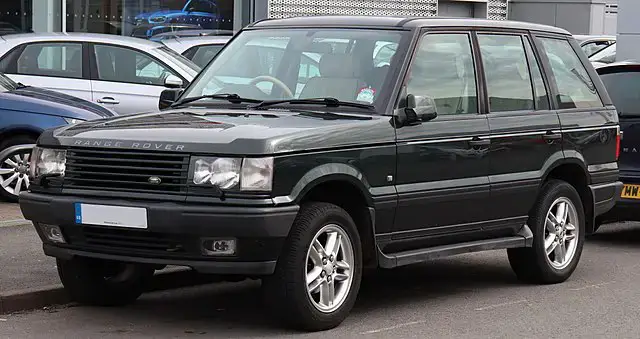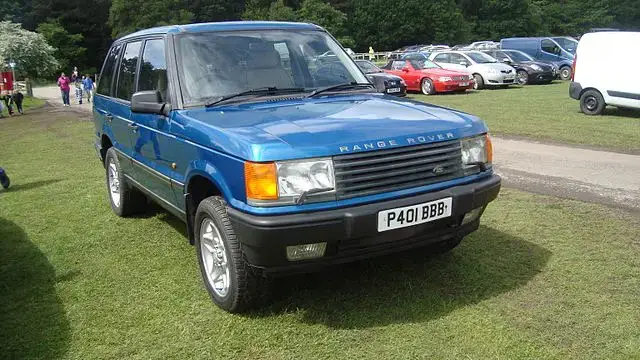Review : Range Rover P38 ( 1994 – 2001 )

I recently listened to Blu Cantrell – Breathe and the lyrics go “All we do is make up and break up” and I immediately thought of the Range Rover P38. Range Rover P38, a car worthy of being a guest on Love Island.
Let me give you a short intro and tell you why the Range Rover P38 was betrayed and why it was a rebellious child worthy of “Outnumbered”, I must tell you that the Range Rover P38 appeared in 1994. You know what else happened in 1994? Land Rover was bought by BMW and the P38 was the first victim to use BMW parts, having both Rover and BMW sourced engines.
I was talking about Ford and about the thefts in the car industry, how they bought Mazda and Volvo and “borrowed” their technology, then these companies were left like at the dentist – in pain and with their money taken. And BMW pulled exactly the same move with Land Rover.

By 1997 the Mercedes ML appeared to steal the show, the first large-sized SUV (medium sized in the US) capable of driving on the road. Sort of. In other words, the first status symbol SUV. The original Chelsea tractor. It’s just that the ML had already announced all the way back in 1991 that it would enter the development stage together with those from Mitsubishi, and BMW said it wants a piece of this cake because it is potential and they saw an opportunity in the deceased Land Rover. Under the umbrella of the famous British Leyland, the car factories in our England were full of model employees, constantly drunk and with a work ethic worthy of Pre-Malone and with skills just as impeccable. This meant that the Daihatsu Cuore was a Rolls Royce compared to what was coming out of the doors of British Leyland, a fact for which they went bankrupt in 1988 and the brands were separated. Rover was going to be bought by BMW in 1994 and this is how they found their 4×4 technology with which to answer to the Mercedes ML, without wasting time with the development from scratch.
The problem was that you would believe that Rover was saved by BMW, and you would be wrong. BMW were actually interested in the technology from the Range Rover to launch their very own X5, the ultimate Chelsea tractor that would explode this car segment. And this was further reinforced by the X5 receiving the best available engines from BMW at the time and the Range Rover P38 stuck with the old engines from the Discovery and received only a microscopic 2.5 diesel from BMW. Instead it donated the 4×4 technology and about 25 years of history so that in 2001 it could be sold on to Ford.

Range Rover P38 Engines
Petrol
- 4.0 Rover V8 of 188 and 190 horsepower – Very important distinction because they are essentially the same Rover engine, only that the 190 version uses the GEMS injection system which is the same age as Ur Zababa, and the 188 version uses the Bosch injection system aka the Thor engine. You will often hear discussions about GEMS and Thor when you read anything about old Land Rovers.
- 4.6 Rover V8 of 225 and 218 horsepower – It’s the same Rover V8 only stretched to 4.6 and similarly the 225 horsepower version is the GEMS version and the 218 one is the Thor version. Otherwise, the same garbag… I mean Rover engine.
Diesel
2.5 tds M51 of 136 horsepower – The antique M51 that was fitted to BMW 3 Series E36, 5 Series E34, 7 Series E38, 5 Series E39 and Opel Omega. In other words, you can find replacement parts literally everywhere. The only real weak point is the turbo, otherwise this engine can go for billions of km. On the other hand, it is quite limited to off-roading because the performance on the tarmac are modest to be generous. With a 0-100 time of 15.8 seconds for the automatic version and 14.3 for the manual version, you stand no chance against the 1.4 MPI entry-level Dacia Logan which had a 0-100 of 13 seconds. Apart from the 2.0 SDI naturally aspirated diesel Caddy which has a 0-100 time of 20.5 seconds, I don’t know what else you could overtake.

Range Rover P38 Common Issues
- The Rover V8 engine is as good as running on ice. Like a warm pillow on both sides when you try to sleep at night. If it were a person, it would try to grab the water after slipping on the wet floor in the shower. Would take a roulette to the bed to see how much he slept. Serious issues with the engine block, which has thinner walls than the plot behind Spongebob Musical, and this leads to coolant leaks and grilled cylinder heads. But wait, there’s more. O2 sensors are thinner than your wallet 2-3 days before salary day, so the engine will never know how much petrol it needs and it will just beg for as much as it can physically take on.
- The optional air suspension on the Range Rover P38 is one of the major headaches with this model. There are people who switched the suspension to classic coilovers, but in this scenario you will have issues with the MOT and any police or law enforcement that wants to check your car. If you don’t want to work on it constantly and set a website site with air bags and compressors for Range Rover as your default main page in Chrome, buy a model with clasic coilovers.
- The ZF automatic gearbox is light years ahead of the manual box in terms of reliability, with the manual gearbox having issues with the synchros and it tends to jump out of gear.
- It’s a Land Rover with minimal improvements from BMW, so you’ll have constant electric gremlins. Very rarely will all buttons and all equipment work at the same time. Bonus points for the air conditioning compressor which is probably the most common and famous issue of them all.
- Many have probably placed the original radio module but it’s worth mentioning. The Radio module picks the closest frequencies and processes them as if they were the frequency from the car’s keys. This means that the car is locking/unlocking because the immobilizer works hard until the battery runs flat and leaves you stranded. The solution is either to change the radio module or to park far from telecommunications antennas or Wi-Fi devices or anything that uses telecommunications and radio waves (even a trivial portable weather station). I’m not making this up. I couldn’t even if I had my regular 6 pack before work.

Range Rover P38 Verdict
A car with more problems than Jay-Z. However, if you go for the coilover suspension + BMW 2.5 diesel engine + automatic transmission combo you have one of the most reliable Range Rovers of recent times. And this is especially true in the mountainous area where it is full of P38 Range Rovers . A car built only to have its technology stolen and to give birth to the dubious BMW X5 E53 and at the same time being one of the most capable mountain cars that you can buy with not so much money.
Which engines do I recommend? For petrol you can for both of them as they are pretty much the same engine, but if you want to keep the running costs decent.
Similar Articles

Review : Toyota Verso AR20 ( 2009 – 2013 )

Review : Skoda CitiGO ( 2011 - 2020 )

Review : Seat Mii ( 2011 - 2020 )
Write an answer
- Review : Toyota Verso AR20 ( 2009 – 2013 ) 10 November 2025
- Review : Skoda CitiGO ( 2011 - 2020 ) 02 August 2025
- Review : Seat Mii ( 2011 - 2020 ) 02 August 2025
- December 2025
- November 2025
- October 2025
- August 2025
- July 2025
- April 2025
- March 2025
- February 2025
- January 2025
- December 2024
- November 2024
- October 2024
- August 2024
- July 2024
- June 2024
- May 2024
- April 2024
- March 2024
- February 2024
- January 2024
- December 2023
- November 2023
- October 2023
- September 2023
- August 2023
- July 2023
- June 2023
- May 2023
- April 2023
- March 2023
- February 2023
- January 2023
- December 2022
- November 2022
- October 2022
- September 2022
- August 2022
- July 2022
- June 2022
- May 2022
- March 2022
- April 2021
- January 2021
- December 2020
- November 2020
- October 2020
- September 2020
- August 2020
- July 2020
- March 2020